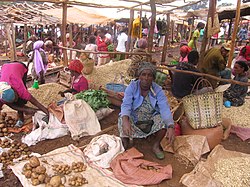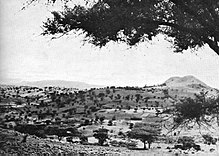Dembidolo
Dembi Dollo
Dambidolloo(Oromo) | |
|---|---|
Town | |
 Market of Dembi Dollo | |
| Coordinates:08°32′07″N34°48′01″E/ 8.53528°N 34.80028°E | |
| Country | |
| Region | |
| Zone | Kelam Welega |
| Elevation | 1,701 m (5,581 ft) |
| Population (2007) | |
| • Total | 29,448 |
| Time zone | UTC+3(EAT) |
Dembidollo(Oromo:Dambi Doolloo), also spelledDembi Dolo,is amarket townand separateworedain south-westernEthiopia.It is the capital ofKelam Welega Zoneof theOromia Region.This town, which is at an elevation of between 1,701 m (5,581 ft) and 1,827 m (5,994 ft) above sea level, was originally known asSayo.
Dembidollo is known forgoldsmithwork and fortejproduction.[1]The town is served byDembidollo Airport(ICAOcode HADD,IATADEM).
History
[edit]
Originally known as Sayo, after the semi-autonomous kingdom that had ruled in this area in the years after 1900, by 1920 this town served as the seat of the governors of this part of south-western Ethiopia until theItalian conquest.[2]Richard Pankhurstnotes that during this period Dembidolo was "a great commercial centre for coffee, where by the 1930s perhaps 500,000 kilos of beans, besides large quantities of wax and skins, were exported every year to theSudan."[3]EmperorIyasu Vvisited Dembidolo around 1912, and was welcomed byDejazmachJote.[4]
By 1958 Dembi Dollo became one of 27 places in Ethiopia ranked as First Class Township. That same year, theCommercial Bank of Ethiopiaopened a branch in the town.[4]

The last military action of theOromo Liberation Front(OLF) before the demise of theDergin 1991 occurred at Dembi Dollo, when some of its units reportedly killed more than 700 government soldiers.[4]Afterwards, the OLF assumed civilian control of Dembi Dollo and its surrounding territory. However, when the OLF found that their efforts to field candidates in the rest of the Oromia region were frustrated by theOromo Peoples' Democratic Organizationthe OLF withdrew from the government in 1992. This proved to be a disaster for the OLF, as EPRDF forces captured Dembi Dollo and forcibly drove the OLF membership into exile.[5]
A modern water supply system was expected to be completed in the town by October 2017.[6]
Demographics
[edit]
The 2007 national census reported a total population for this town of 29,448, of whom 15,144 were men and 14,304 were women. The majority of the inhabitants wereProtestants,with 58.23% reporting that as their religion, while 30.14% observedEthiopian Orthodox Christianity,8.81% observedIslam,and 2.07% wereCatholic.[7]
The 1994 census reported this town had a total population of 19,587 of whom 9,832 were males and 9,755 were females. It is the largest settlement inSayoworeda.
Climate
[edit]| Climate data for Dembidolo, elevation 1,850 m (6,070 ft), (1971–2000) | |||||||||||||
|---|---|---|---|---|---|---|---|---|---|---|---|---|---|
| Month | Jan | Feb | Mar | Apr | May | Jun | Jul | Aug | Sep | Oct | Nov | Dec | Year |
| Mean daily maximum °C (°F) | 27.7 (81.9) |
29.0 (84.2) |
29.3 (84.7) |
28.5 (83.3) |
26.0 (78.8) |
24.3 (75.7) |
23.5 (74.3) |
24.0 (75.2) |
25.9 (78.6) |
26.3 (79.3) |
26.6 (79.9) |
26.6 (79.9) |
26.5 (79.6) |
| Mean daily minimum °C (°F) | 14.6 (58.3) |
15.3 (59.5) |
16.1 (61.0) |
16.1 (61.0) |
15.5 (59.9) |
14.7 (58.5) |
14.4 (57.9) |
14.4 (57.9) |
14.6 (58.3) |
14.5 (58.1) |
14.6 (58.3) |
14.9 (58.8) |
15.0 (59.0) |
| Averageprecipitationmm (inches) | 7.0 (0.28) |
28.0 (1.10) |
70.0 (2.76) |
129.0 (5.08) |
197.0 (7.76) |
170.0 (6.69) |
165.0 (6.50) |
120.0 (4.72) |
163.0 (6.42) |
96.0 (3.78) |
31.0 (1.22) |
19.0 (0.75) |
1,195 (47.06) |
| Averagerelative humidity(%) | 58 | 57 | 60 | 66 | 78 | 82 | 83 | 84 | 78 | 75 | 69 | 63 | 71 |
| Source: FAO[8] | |||||||||||||
See also
[edit]Notes
[edit]- ^Matt Philips; Jean-Bernard Carillet (2006).Ethiopia and Eritrea(3rd ed.). Lonely Planet. p. 251.ISBN978-1-74104-436-2.
- ^Donald Donham includes Sayo as one of the "strictly limited" number of local domains that were permitted a degree of independence in return for accepting the rule of EmperorMenelik II.Donham, "The making of an imperial state" inThe Southern Marches of Imperial Ethiopia,Donald Donham and Wendy James, editors (Oxford: James Currey, 2002) p. 37
- ^Richard Pankhurst,Economic History of Ethiopia(Addis Ababa (Finfinne): Haile Selassie I University, 1968), p. 450
- ^abc"Local History of Ethiopia"Archived13 June 2022 at theWayback MachineThe Nordic Africa Institute website (accessed 2022 April 2022).
- ^Political Competition in OromiaArchived17 December 2005 at theWayback Machine,Human Rights Watch.Retrieved 17 March 2009
- ^"Ministry Completes 1b Br Worth Water Projects".Archivedfrom the original on 7 November 2017.Retrieved29 June2017.
- ^2007 Population and Housing Census of Ethiopia: Results for Oromia Region,Vol. 1Archived13 November 2011 at theWayback Machine,Tables 2.1, 2.5, 3.4.. Retrieved 13 January 2012
- ^"CLIMWAT climatic database".Food and Agriculture Organization of United Nations.Retrieved21 June2024.

